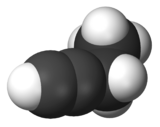1-Butyne
Appearance

| |

| |
| Names | |
|---|---|
| IUPAC name
but-1-yne
| |
| Other names
But-1-yne
Ethylacetylene Ethylethyne | |
| Identifiers | |
3D model (JSmol)
|
|
| ChEBI | |
| ChemSpider | |
| ECHA InfoCard | 100.003.139 |
| EC Number |
|
PubChem CID
|
|
| UNII | |
| UN number | 2452 |
CompTox Dashboard (EPA)
|
|
| |
| |
| Properties[1] | |
| C4H6 | |
| Molar mass | 54.091 g/mol |
| Density | 0.6783 g cm−3[1] |
| Melting point | −125.7 °C (−194.3 °F; 147.5 K)[1] |
| Boiling point | 8.08 °C (46.54 °F; 281.23 K)[1] |
| Hazards | |
| GHS labelling: | |
 
| |
| Danger | |
| H220, H280 | |
| P210, P377, P381, P403 | |
Except where otherwise noted, data are given for materials in their standard state (at 25 °C [77 °F], 100 kPa).
| |
1-Butyne, also known as ethylacetylene, but-1-yne, ethylethyne, and UN 2452, is an extremely flammable and reactive alkyne with chemical formula Template:Carbon4Template:Hydrogen6 and CAS number 107-00-6 that is used in the synthesis of organic compounds. It occurs as a colorless gas.[1]

